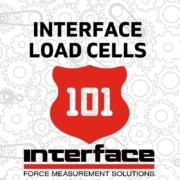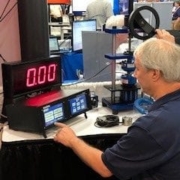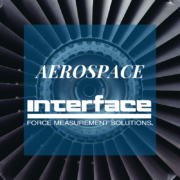Types of Testing Applications Using Load Cells
 Interface provides industries worldwide with comprehensive solutions for a range of testing needs. As a leader in test and measurement, we offer an extensive range of sensor designs, capacities, and configurations, supported by instrumentation and accessories, to perform these tests with high-quality devices and deliver precise results.
Interface provides industries worldwide with comprehensive solutions for a range of testing needs. As a leader in test and measurement, we offer an extensive range of sensor designs, capacities, and configurations, supported by instrumentation and accessories, to perform these tests with high-quality devices and deliver precise results.
In our types of testing series, we outline 15 types of tests, including tension, compression, torque, material, and structural. These quick references are designed to deepen your understanding of Interface’s capabilities in supporting your testing applications through examples from industry use cases.
Part one of this series focuses on the most popular testing types that use Interface products, including our load cells, torque transducers, multi-axis sensors, and instrumentation devices.
TIP: Use our product selection guides to help you review the products suited to your testing requirements.
Top Testing Types and Industry Use Cases
STRESS TESTING
Stress testing involves subjecting different materials or structures to simulated operational loads to evaluate their performance and durability. Load cells monitor stress and deformation, providing boundary conditions for stress analysis.
- Infrastructure engineers commit to thorough stress testing to assess the stress distribution in bridge components under various traffic loads.
- Energy suppliers use stress testing to assess the tension levels in pipelines under varying pressure and temperature conditions.
- Turbomachinery manufacturers evaluate stress in turbine blades under high-speed rotation.
Additional industry stress testing references:
- Stress Testing 101
- Load Cells Built for Stress Testing
- Airplane Static Stress Testing
- Beam Stress Test
- How Sensor Technologies Help Build Better Highways, Bridges and Roadways
- Examining Force Measurement in Subsea Oil and Gas
TENSION TESTING
Tension testing measures the force required to pull a material until it breaks, revealing tensile strength and elongation. Load cells quantify the applied tensile force. Load cells with appropriate force ranges and high sampling rates capture material behavior during tension. Proper specimen gripping and load cell axis alignment are crucial.
- Steel manufacturing uses tension testing to determine the tensile strength of steel wires and cables.
- Textile industry product makers and machine designers utilize tension testing to assess the strength and elasticity of fabrics and yarns.
- Medical device researchers and manufacturers require accurate tension testing to determine the tensile strength of surgical sutures and implants.
Additional industry tension testing references:
- Tension Load Cells 101
- How Does Tensile Testing Work?
- Jib Crane Tension Monitoring
- Power Line Tension Testing, Mooring Line Tension Testing
- Bolt Tension Monitoring
- Manufacturing: Material Tensile Testing
- Fabric Winding Machine
- Yarn Tension Monitoring
- Optimizing Medical Device Performance with Precise Force Measurement
FATIGUE TESTING
Fatigue testing simulates cyclic loading to determine a material’s resistance to repeated stress and reveal its fatigue life. Load cells monitor applied loads and deformations, and high-speed data acquisition systems capture load and deformation data for analysis. Accurate control of cyclic loading and precise measurement are essential. Fatigue-rated load cells are ideal.
- Automotive components undergo fatigue testing to determine the fatigue life of suspension, engine, and auto parts.
- Aerospace structural engineers assess aircraft wings’ and fuselage fatigue resistance through ongoing fatigue testing.
- Medical implants submit to extensive fatigue testing to understand the lifecycle of artificial joints, prosthetics, and bone plates.
Additional industry fatigue testing references:
- Mastering Fatigue Testing With Force Measurement Webinar
- Bike Frame Fatigue Testing
- Furniture Fatigue Cycle Testing
- Gaming Chair Fatigue Testing
- Automotive Head Rest Testing
- Aircraft Wing Fatigue
- Prosthetics Load and Fatigue Testing
COMPRESSION TESTING
Compression testing measures the force required to crush or compress a material, revealing compressive strength. Load cells quantify applied force. High-capacity load cells are necessary for large forces. Proper specimen and load cell alignment is crucial.
- Construction and infrastructure engineers and test labs use compression testing to determine the compressive strength of concrete, masonry, and soil.
- Manufacturers and packaging makers require compression tests to evaluate the crush resistance of packaging materials.
- Materials science researchers utilize compression testing to determine the compressive strength of advanced materials used in the aerospace and automotive industries.
Additional industry compression testing references:
- Wood Compression Testing, Soil Compression Testing
- Spring Compression Testing.
- 1101 Compression-Only Ultra Precision LowProfile Load Cell
- Concrete Compression Testing
- Force Measurement for Efficiency in Food Processing and Packaging
- Overlapping Material Science and Force Measurement
STRUCTURAL TESTING
Structural testing assesses the integrity and performance of structures under static and dynamic loads. Load cells monitor structural behavior, with distributed load cells tracking stress and deformation. Data acquisition systems capture sensor data for structural analysis. Proper sensor placement and boundary conditions are vital.
- Building design engineers and architects use structural testing to verify the load-bearing capacity of beams and columns.
- Shipbuilders require structural testing to assess the integrity of ship hulls under the influence of wave loads.
- Renewable energy companies conduct structural testing on the response of wind turbine blades to wind loads.
Additional industry structural testing references:
- Enhancing Structural Testing with Multi-Axis Load Cells
- Interface Measurement Solutions for Shipbuilding From Hull to Deck
- Windmill Energy
- Performance Structural Loading
- Rocket Structure Testing
- Electric Vehicle Structural Battery Testing
TORQUE TESTING
Torque testing evaluates the rotational force applied to an object, revealing torsional strength and fastener integrity. Torque transducers quantify applied torque, and rotary torque transducers measure applied torque.
- Automotive assembly verifies torque applied to bolts and fasteners in engine assembly through extensive torque testing.
- Power tool test labs use torque testing to ensure the accuracy of torque wrenches and screwdrivers.
- Aerospace industry torque tests ensure the integrity of critical aircraft fasteners.
Additional industry torque testing references:
- Torque Transducers Review Plus Glossary of Torque Terms
- Bolt Fastening Force and Torque
- E-Bike Torque Measurement
- Torque Verification
- Aircraft Screwdriver Fastening Control
- Tractor PTO Torque Testing
- Fuel Pump Optimization
- Chocolate Melanger Torque
- Aircraft Yoke Torque Measurement
MATERIAL TESTING
Material testing characterizes material properties, including strength, elasticity, and hardness, tailored to meet specific industry needs. Load cells, torque transducers, and multi-axis sensors measure materials’ mechanical properties. Proper sensor calibration and adherence to industry-standard testing methods are vital for accurate results.
- Construction companies and suppliers conduct material testing to ensure the structural integrity of buildings, bridges, and infrastructure.
- Aerospace manufacturers guarantee the safety and reliability of aircraft and spacecraft through comprehensive material testing programs.
- Manufacturers apply material testing for quality control, product development, and failure analysis.
Additional industry material testing references:
- Overlapping Material Science and Force Measurement
- Interface Load Cells 501 Materials and Process Control Testing Guide
- Material Tensile Testing
- Interface Solutions for Material Testing Engineers
- Tensile Testing for 3D Materials
- Force Measurement is Fundamental in Material Testing
- Smart Food Packaging Uses Force Measurement
STRAIN TESTING
Strain testing measures the deformation of a material under stress, revealing its elastic and plastic behavior. Load cells measure this deformation, and high-sampling-rate data acquisition systems capture dynamic strain changes.
- Automotive engineers utilize strain testing to assess the strain distribution in chassis components, suspension systems, and engine parts, ensuring durability and safety.
- Aerospace engineers use strain testing to measure the structural integrity of aircraft wings, fuselages, and engine components and assess their fatigue life under various strain levels.
- Civil engineers utilize strain testing to assess the structural behavior of bridges, buildings, and dams under load, confirming structural integrity and identifying potential failures.
Additional industry strain testing references:
- Strain Testing 101
- Interface Measurement Solutions for Industry Testing Labs
- Leveraging Load Cells for Reliable Brake Testing
Understanding the connection between testing types and the practical implementation of interface technologies offers industry leaders and innovators valuable insights into bringing new products to market and enhancing their capabilities to meet these demands. Our products are designed to help engineers and test labs advance their concepts into prototypes and market-ready products.
Types of testing can be continuous for performance monitoring or to test the boundaries of performance in structures and materials. Ultimately, the data will drive better decisions with tests that use reliable, quality, and accurate measurement solutions.
Accurately selecting a load cell or any sensor device with appropriate capacity, sensitivity, and environmental specifications, along with precise signal conditioning and data acquisition instruments, directly influences the reliability and accuracy of test results. This ensures engineers can confidently acquire and interpret data, leading to improved product designs, safer structures, and more efficient processes.







